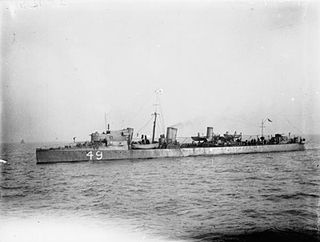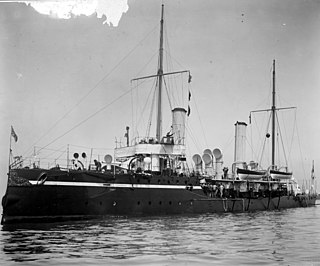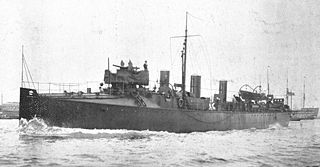
HMS Bat was a Palmer-built three funnel, 30 knot torpedo boat destroyer ordered by the Royal Navy under the 1895 – 1896 Naval Estimates. She was the third ship to carry this name since it was introduced in 1815 for a revenue cutter in service until 1848. Bat was classified along with similar vessels as a C-class destroyer in 1913.
HMS Seal was a B-class torpedo boat destroyer of the British Royal Navy. She was completed by Laird, Son & Company, Birkenhead, in 1897.
HMS Panther was a B-class torpedo boat destroyer of the British Royal Navy. She was completed by Laird, Son & Company, Birkenhead, in 1897.
HMS Earnest was an "thirty-knotter" torpedo boat destroyer of the British Royal Navy. She was built by Laird, Son & Company at their Birkenhead shipyard as one of six Earnest-class destroyers ordered as part of the Royal Navy's 1895–1896 construction programme, which were later classified as members of the B-class. Earnest was launched on 7 November 1896 and was completed in November 1897.
HMS Zebra was a "Twenty-seven Knotter" destroyer of the Royal Navy, later classified as part of the A Class. Zebra was built by Thames Iron Works and launched in 1895 as the fifth Royal Navy ship to be named Zebra. Entering service in 1900, Zebra was sold for scrap in 1914.

HMS Zephyr was one of two Fervent-class destroyers which served with the Royal Navy. She was launched on 10 May 1895 from Hanna, Donald & Wilson at Paisley, Scotland. She served in home waters, and was sold in 1920.

HMS Conflict was the lead ship of the Conflict-class destroyers built by J. Samuel White, at East Cowes, Isle of Wight for the Royal Navy. She was launched on 13 December 1894, and entered service in 1899. After an initial spell in the Mediterranean Fleet, Conflict returned to British waters, where she served the rest of her career. Conflict was part of the Portsmouth Local Defence Flotilla during the First World War, which she survived. Conflict was sold for scrap on 20 May 1920.
HMS Peterel was one of two Spiteful-class destroyers to serve with the Royal Navy. She was built by Palmers, was 215 feet long and the 6,200 H.P. produced by her Reed boilers gave her a top speed of 30 knots. She was armed, as was standard, with a twelve pounder and two torpedo tubes. She served in home waters throughout the Great War and was sold off in 1919.
HMS Syren was one of two Myrmidon-class destroyers which served with the Royal Navy. She was launched by Palmers in 1900, served in home waters and was sold off, after the First World War, in 1920.

HMS Dove was a three funnel, 30 knot destroyer ordered by the Royal Navy under the 1896–1897 Naval Estimates. She was the ninth ship to carry the name.
HMS Leopard was a Vickers three funnel - 30 knot destroyer ordered by the Royal Navy under the 1895 – 1896 Naval Estimates. She was the ninth ship to carry this name since it was introduced in 1635 for a 34-gun ship, captured by the Dutch in 1653.

HMS Flirt was a Palmer three funnel, 30 knot destroyer ordered by the Royal Navy under the 1896 – 1897 Naval Estimates. She was the fifth ship to carry this name since it was introduced in 1782 for a 14-gun brig in service until 1795.
HMS Rother was a Palmer type River-class destroyer ordered by the Royal Navy under the 1902–1903 Naval Estimates. Named after the River Rother, east of Sheffield, South Yorkshire in England, she was the first ship to carry this name in the Royal Navy.

HMS Kestrel was a Clydebank-built three funnelled 30-knot destroyer ordered by the Royal Navy under the 1895 – 1896 Naval Estimates. She was the fourth ship to carry this name since it was first used in 1846 for a brigantine.

HMS Circe was a Alarm-class torpedo gunboat of the British Royal Navy. She was built by Sheerness Dockyard from 1890–1893. She was converted to a minesweeper in 1908–1909 and continued these duties during the First World War. Circe was sold for scrap in 1920.
HMS Leda was an Alarm-class torpedo gunboat of the British Royal Navy. She was built by Sheerness Dockyard from 1891–1893. She was converted to a minesweeper in 1908–1909 and continued these duties during the First World War. Leda was scrapped in 1922.

HMS Speedy was a Alarm-class torpedo gunboat of the British Royal Navy. She was built by Thornycroft from 1892–1894. She was converted to a minesweeper in 1908–1909 and continued these duties during the First World War. Speedy was sunk by a German mine on 3 September 1914.

HMS Jason was a Alarm-class torpedo gunboat of the British Royal Navy. She was built by the Naval Construction & Engineering Co. from 1891–1893. She was converted to a minesweeper in 1908–1909 and continued these duties during the First World War. Jason was sunk by a German mine on 7 April 1917.
HMS TB 5 was a Cricket-class coastal destroyer or torpedo-boat of the British Royal Navy. TB 5 was built by the shipbuilder J S White from 1905 to 1907. She was used for local patrol duties in the First World War and survived the war. She was sold for scrap in 1920.

HMS Ranger was a "twenty-seven knotter" torpedo boat destroyer of the British Royal Navy. Built by the Tyneside shipbuilder Hawthorn Leslie, Opossum was one of three destroyers built by Hawthorns that were ordered in 1894. She was launched in 1895 and completed in 1896. She remained in service during the First World War, where she was used for local patrol duties. She was sold for scrap in 1920.









